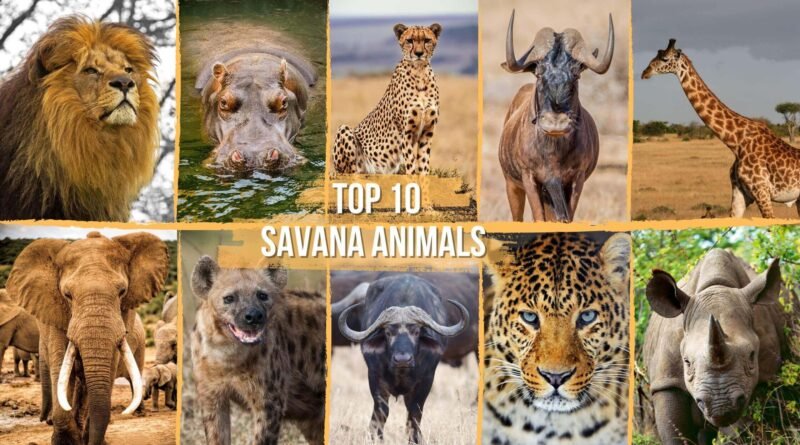Top 10 animals of the African Savanna
The African Savanna, also known as the African grassland or savanna biome, is a remarkable ecosystem with abundant biodiversity. It is home to a wide variety of savanna animals that have adapted to survive in this unique and sometimes challenging environment.
One of the most iconic animals of the African Savanna is the African bush elephant, the largest land mammal on Earth. These majestic creatures roam the savannas of sub-Saharan Africa, moving between different habitats during the dry and wet seasons.
In addition to elephants, the African Savanna is inhabited by many other animals such as grazing animals like the plains zebra and blue wildebeests. These animals form family groups and migrate long distances in search of food and water during different seasons.
Predators like lions and spotted hyenas also thrive in the savanna biome. With their keen senses and hunting abilities, they play a crucial role in maintaining the balance of the ecosystem by preying on herbivores.
The savannas are characterized by open grasslands, scattered trees, and patches of open woodlands. The tall grasses provide cover for small groups of animals, while the open areas allow for the movement and visibility of larger animals.
The African Savanna is not limited to Africa alone. Similar ecosystems can be found in other parts of the world, including South America, the Middle East, and parts of Australia. Although the specific species may differ, the general characteristics of savannas remain consistent.
Overall, the African Savanna is a captivating and diverse ecosystem that supports a wide array of plant and animal life. From the tallest mammals with long necks to the fastest animals on land, the savannas are teeming with life and offer a fascinating glimpse into the wonders of nature.
African Savanna: what is it?
The African Savanna, also known as the African grassland, covers a vast area of the African continent. It stretches across multiple regions, including Southern Africa, West Africa, and Eastern Africa. This unique ecosystem is home to a wide variety of savanna animals, such as elephants, zebras, and many other fascinating creatures.
The vegetation in the African Savanna mainly consists of tall grasses and scattered trees. Depending on factors like location, climate, and soil type, the vegetation can vary from dense trees with plenty of shade to more open areas dominated by low grasses and herbaceous plants.
The African Savanna has adapted to survive in the face of various challenges, including periodic fires. The plants in this region have developed mechanisms to recover and regenerate after fires. Grasses, for example, have meristems at their base, which allow them to regenerate and recover from fire damage. Trees also have defense and recovery systems, such as thick bark and underground buds that give rise to new shoots and branches after a fire.
The savanna is a habitat where predators and prey coexist. It is home to many animals, including the African bush elephant, which is the largest land animal in the world. Other notable species include the plains zebra, known for its distinctive black and white stripes, and medium-sized mammals with brown fur. Predators roam the savanna, relying on their speed and agility to hunt.
The climate in the African Savanna is characterized by distinct wet and dry seasons. During the rainy season, the savanna comes to life with vibrant vegetation and an abundance of water sources. In contrast, the dry season presents challenges for both plants and animals, as resources become scarce. Despite these challenges, the animals of the savanna have adapted to survive in this dynamic environment.
The African Savanna is not only unique to Africa but also shares similarities with other savannas around the world, including those in South America and the Middle East. These ecosystems are characterized by open woodlands, semi-deserts, and long periods of drought.
In conclusion, the African Savanna is a remarkable ecosystem teeming with life and diversity. Its vast plains, grazing animals, and incredible adaptations make it a truly awe-inspiring habitat.
African Savanna and local human communities
The African Savanna also plays a very important role for local communities who recognize the interdependence between them. Numerous natural resources are provided by the Savanna to communities, including water, medicinal plants, timber, and pasture for livestock farming. In addition to herding, in some regions, there is subsistence agriculture, as well as wildlife tourism, a source of income and jobs.
Top 10 animals of the African Savanna
Now that we know what the African Savanna is, let’s get to know the 10 most iconic animals that live there. Let’s go!

Lion (Panthera leo)
It is the king of the jungles and one of the largest carnivores in the African Savanna, a symbol of strength and power. The lion is mainly found in the extensive Savanna plains and they have defined territories within the savanna, which are defended against other invading lions. As they are predators at the top of the food chain, their presence regulates the populations of other animals and maintains ecological balance. Its conservation status is considered “vulnerable” by the International Union for Conservation of Nature and Natural Resources (IUCN).

African Savanna elephant (Loxodonta africana)
The lion may be the king of the jungles, but the elephant is not far behind: it is one of the largest land mammals on the planet! One of Africa’s most iconic animals, the African elephant is known for its intelligence and memory, its strength, and its complex forms of social interaction. Their “families”, the so-called herds, are always led by the matriarch, the oldest and most experienced female in the group, and the cooperative behavior between individuals is one of the strongest found in the animal kingdom. Unfortunately, African elephants are endangered, according to the IUCN.
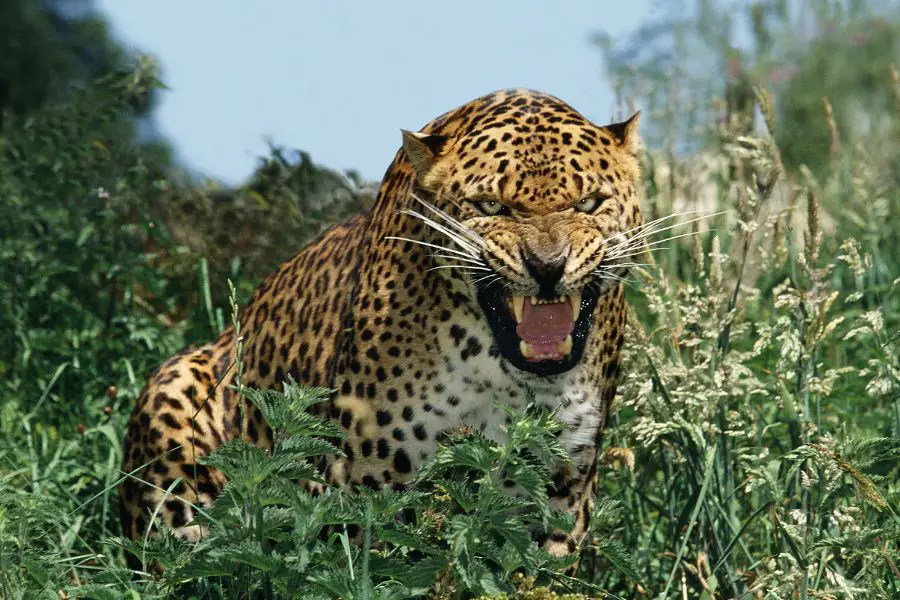
Leopard (Panthera pardus)
One of the most mysterious predators in the animal kingdom, the Leopard, not only inhabits the African Savanna, however, it is one of the most emblematic animals there. They can also be found in Asian locations and in tropical forests and mountain forests. Its camouflage ability and stealthy movements make it an extremely skilled hunter. Wild felines, they are excellent climbers, a skill that has adapted over time, so that they can hide from predators and also protect their prey from being stolen by hyenas and lions.

Black and white rhinos (Diceros bicornis and Ceratotherium simum)
There are two types of African rhinos, the black rhino (Diceros bicornis) and the white rhino (Ceratotherium simum). Majestic and imposing, African rhinos need regular access to water to drink and refresh themselves, which is why they prefer to live in places not far from temporary lakes and puddles. Both are critically endangered due to hunting for the illegal trade of their horns. It is estimated that currently, there are only around 5,000 black rhinos and 10,000 white rhinos left living in the wild.
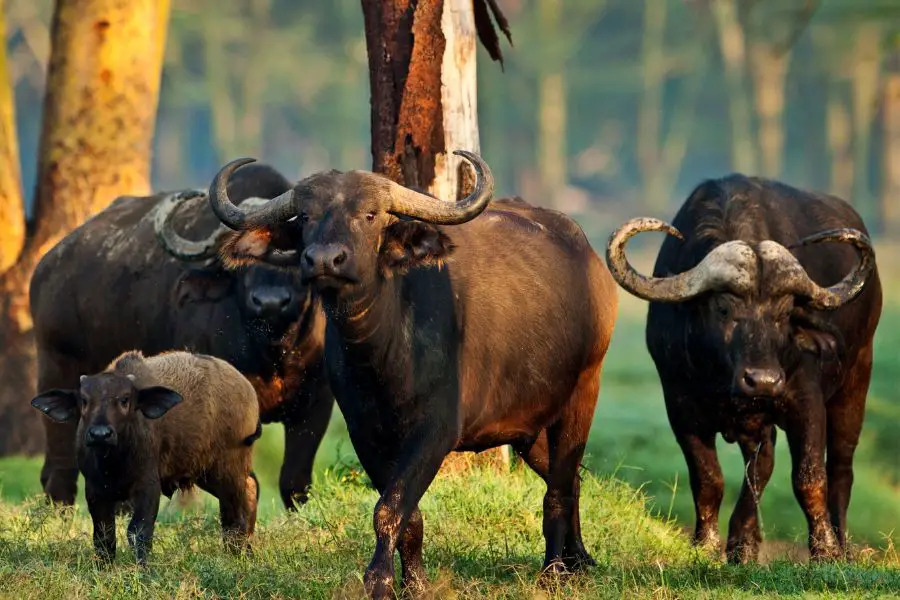
African buffalo (Syncerus caffer)
Similar to an ox, but much larger and braver, it is one of the most threatening animals in the African Savanna. Herbivores, also known as Cape buffalo, these imposing animals can be found in densely wooded areas of Africa, in addition to the Savanna, and feed mainly on grasses and pasture. They are highly collaborative among themselves, even if they come from different herds, which can contain up to hundreds of individuals. With illegal hunting and habitat loss, their status according to the IUCN is near threatened.

Cheetah (Acinonyx jubatus)
The cheetah is considered the fastest land animal of all, reaching speeds of up to 68 mph. Incredible, isn’t it?! Its legs and long tail, along with its flexible spine and semi-retractable claws allow this feline to take steps of up to 22 feet in length. Its body is aerodynamic, with powerful and well-developed muscles, and, in addition, the cheetah has larger lungs and heart than other felines, which gives it greater cardiorespiratory capacity. This entire set of characteristics allows the cheetah to reach explosive speeds in pursuit of its prey. Unfortunately, this magnificent feline is yet another on the list of animals vulnerable to extinction due to habitat loss, reduction in the number of prey, conflicts with humans in local communities, and illegal hunting and trade.
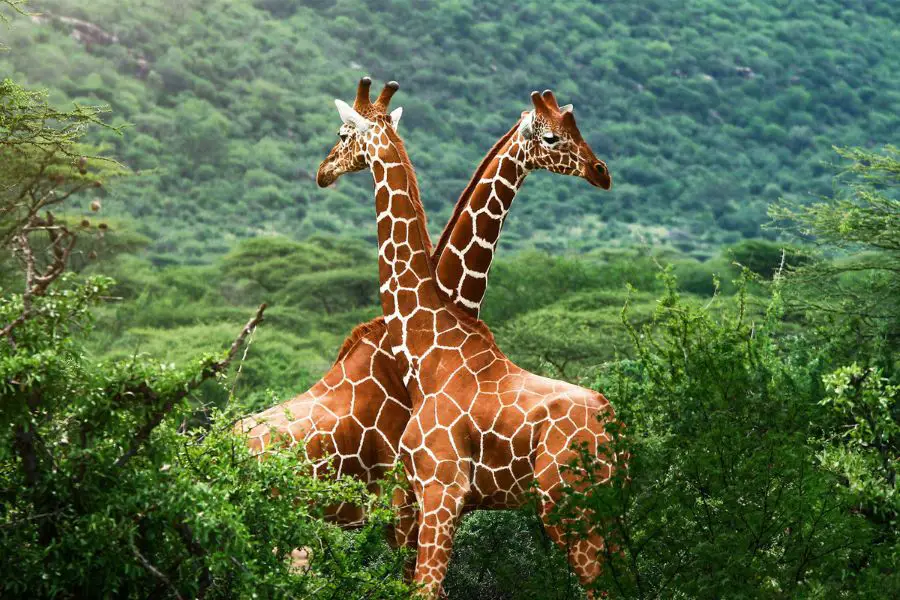
Giraffe (Giraffa camelopardalis)
It may even look clumsy with that huge neck, but that doesn’t make it any less important for the biodiversity of the African Savanna. Giraffes are the tallest mammalian animals on the planet, reaching up to 18 feet in height. This impressive height is an adaptation of their species to the Savanna environment and helps them reach the leaves of taller trees, where much of their food is found. Its long tongue also plays a fundamental role when feeding, as it can extend up to 17 inches in length to reach the most distant leaves. These fascinating animals are at risk of extinction, being listed as vulnerable by the IUCN.
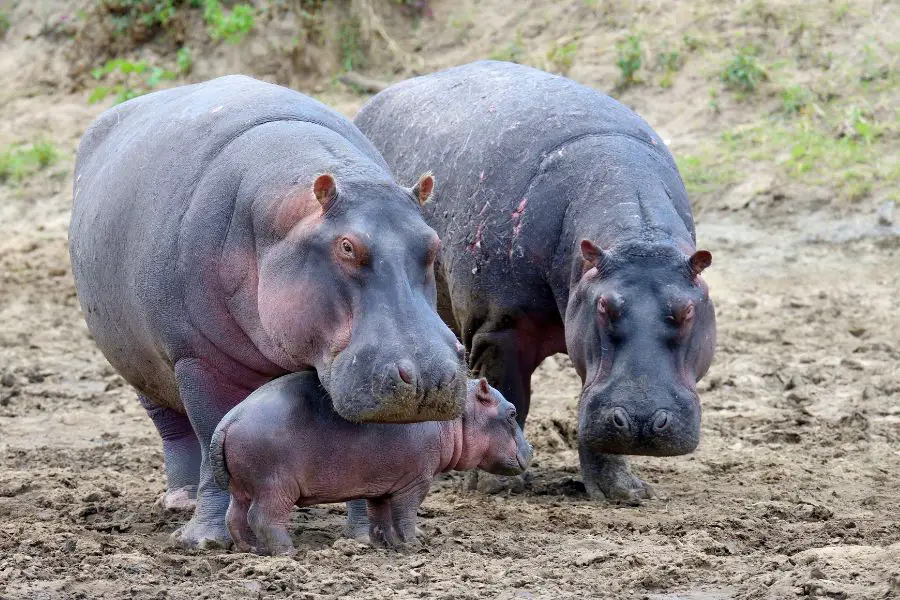
Hippopotamus (Hippopotamus amphibius)
Did you know that hippos are also known as “river horses”? It is believed that this term became common because hippos were able to walk on the bottom of lakes and rivers. Watch the video below, you will be impressed by the skill of these immense mammals.
Another curious fact about these imposing animals is that they make their own “sunscreen”. That’s right! Your skin produces an oily, red substance, a kind of sweat that protects your skin from the sun’s rays. Despite incidents between hippos and humans in local communities, this huge animal is not carnivorous. It never attacks a human being or other animal for food, only to protect itself and its territory. They are herbivorous animals and consume an average of 79 pounds of plants per day. There are also two types of hippos, the common hippopotamus (Hippopotamus amphibius), which is vulnerable, and the pygmy hippopotamus (Choeropsis liberiensis) which is endangered.
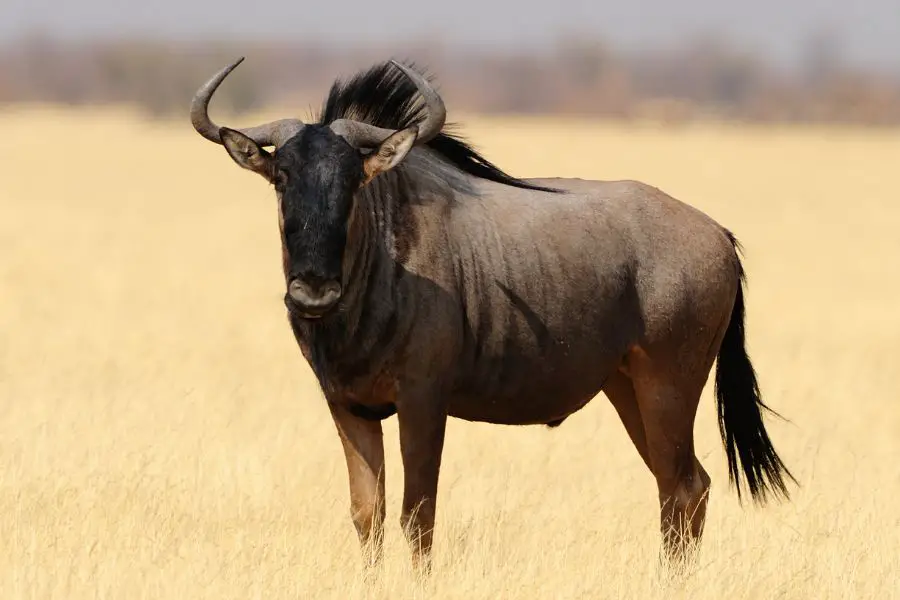
Common and black wildebeest (Connochaetes taurinus and Connochaetes gnou)
There are two types of wildebeest and both are found in the African Savanna, the common wildebeest (Connochaetes taurinus) and the black wildebeest (Connochaetes gnou). These antelopes are famous for their mass migrations, where they travel 497 to 994 miles every year. Such migrations are made by hundreds of “confusions” (collective noun) involving more than a million of these mammals and are an impressive wildlife spectacle. Several documentaries have already been made about this. If you haven’t watched it yet, we suggest you watch it as soon as possible.
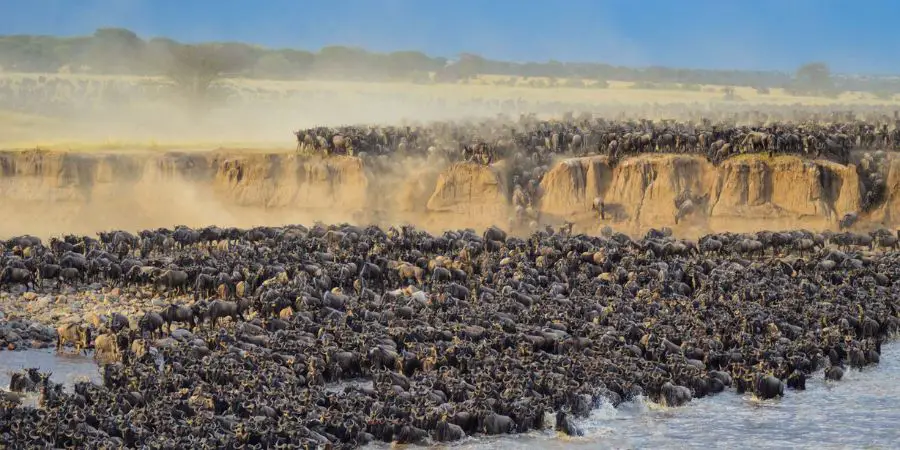
The good news is that neither type of wildebeest is currently endangered.
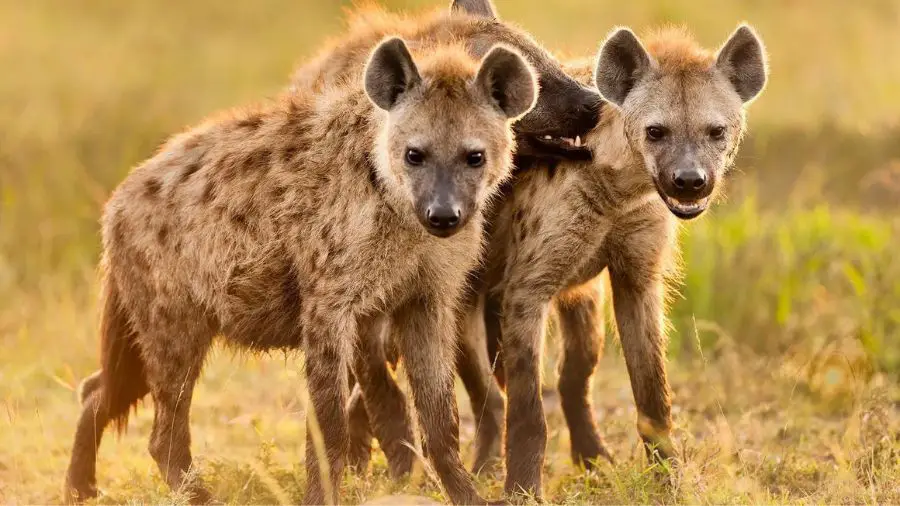
Hyena (Crocuta Crocuta)
They live in clans. Cool, don’t you think? These clans are made up only of females and their cubs and males are only allowed in temporarily during the mating season. There is a strong and complex hierarchical structure and divisions of labor between them: the clan is led by an alpha female, usually the oldest and most experienced. It is up to her to make the most important decisions, such as where to hunt and when and where the group should move in search of new food areas. Adult females are responsible for hunting and defending the territory, while others remain in the clan taking care of the cubs. They are carnivorous animals and anyone who thinks that they only feed on carcasses is mistaken, despite this being a striking characteristic of their species. Hyenas are efficient hunters that work in groups and are capable of chasing and taking down medium and large animals. Another good news: hyenas are also not endangered as well. Yet…
Conclusion
From the majestic lions to the graceful giraffes, we have observed in this article that the African Savanna is a captivating ecosystem, characterized by a rich diversity of savanna animals. This vast region, located in sub-Saharan Africa, experiences distinct seasons, including a dry season and a wet season. During the dry season, the savanna landscape transforms, and the scarcity of water and resources often leads to the sight of dead animals. However, during the wet season, the tropical rainforest thrives, providing relief to the animals of the savanna.
The animals of the savanna have unique adaptations that allow them to survive in this challenging environment. For example, the giraffes’ long necks and legs enable them to reach high foliage, while their large ears help dissipate heat. The African savannas are also home to some of the fastest animals on Earth, including the cheetah, known for its incredible speed.
However, the survival of these animals is under threat. Human actions, such as poaching and habitat destruction, have put many species at risk of extinction. Elephants, in particular, face great dangers due to the demand for their ivory. It is crucial that we urgently come together to protect and conserve these magnificent creatures and their habitats.
The African savannas, with their semi-deserts and grassy plains, are not only home to incredible wildlife but also serve as crucial ecosystems. The presence of predators, such as lions and hyenas, helps maintain a balance in the savanna’s delicate ecology.
In conclusion, the African Savanna is a remarkable place, teeming with life and natural wonders. However, its future hangs in the balance, and it is up to us to ensure a sustainable future for the savannas and the incredible animals that call it home. Let us work together to protect and preserve this precious ecosystem for generations to come.
Until next time! ♥

